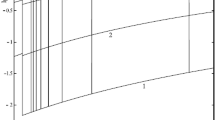Abstract
THERE are now many observations of the 18 cm radio emission from the OH molecules located at the edges of HII regions1. The high intensities, narrow bandwidths, and strong polarizations associated with the emission have led to the conclusion that it is stimulated emission in a collimated beam. The problem of explaining the emission then reduces to a description of the mechanism by which the upper levels in the masering state of the molecule are overpopulated with respect to a thermal distribution. The first suggestions were that the stellar ultraviolet radiation provides a pumping mechanism2,3. It has been pointed out1, however, that the ultraviolet cannot pump at the rate (∼1 cm−3 s−1) necessary for the brightest sources. As an alternative, Solomon4 has argued that because the OH is situated close to an HII region its lifetime must be short, so that overpopulation may be a result of the production mechanism. Here we discuss from this point of view a mechanism for the formation of OH recently proposed by us5.
Similar content being viewed by others
References
Robinson, B. J., and McGee, R. X., Ann. Rev. Astro. Astrophys., 5, 183 (1967).
Perkins, F., Gold, T., and Salpeter, E. E., Astrophys. J., 145, 361 (1966).
Litvak, M. M., McWhorter, A. L., Meeks, M. L., and Zeiger, H. J., Phys. Rev. Lett., 17, 821 (1966).
Solomon, P. M., Nature, 217, 334 (1968).
Stecher, T. P., and Williams, D. A., Astrophys. J., 146, 88 (1966).
Kondrat'ev, V. N., Chemical Kinetics of Gas Reactions (Pergamon Press, Oxford, 1964).
Polanyi, J. C., J. Chem. Phys., 31, 1338 (1959).
Smith, F. T., J. Chem. Phys., 31, 1352 (1959).
Kuntz, P. J., Nemeth, E. M., Polanyi, J. C., Rosner, S. D., and Young, C. E., J. Chem. Phys., 44, 1168 (1966).
Herzberg, G., Spectra of Diatomic Molecules (Van Nostrand, Princeton, 1950).
Phelps, D. H., and Dalby, F. W., Canad. J. Phys., 43, 144 (1965).
Author information
Authors and Affiliations
Rights and permissions
About this article
Cite this article
STECHER, T., WILLIAMS, D. Interstellar OH Excitation. Nature 219, 1138–1139 (1968). https://doi.org/10.1038/2191138a0
Received:
Issue Date:
DOI: https://doi.org/10.1038/2191138a0
- Springer Nature Limited




